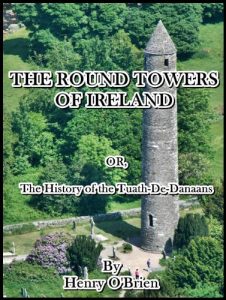The truth is, the “Round Towers” of Ireland were not all intended for one and the same use, nor any one of them limited to one single purpose; and this, I presume, will account for the variety in their construction, not less perceptible in their diameters and altitudes than in other characteristic bearings. For I am not to be told that those varieties we observe were nothing more than the capriciousness of taste, when I find that the indulgence of that caprice, in one way, would defeat the very object to which one party would ascribe them, whilst its extension, in a different way, would frustrate the hopes of another set of speculators.
But what must strike the most cursory as irresistibly convincing that they were not erected all with one view, is the fact of our sometimes finding two of them together in one and the same locality.
Now, if they were intended as beacons or belfries, would it not be the most wasteful expenditure of time and wealth to erect two of them together on almost the same spot? And when I mention expenditure, perhaps I may be allowed, incidentally, to observe, that, of all species of architecture, this particular form, as it is the most durable, so is it also the most difficult and the most costly.
Need I name the sum of money which Nelson’s monument has cost in modern times? or that imperfect testimonial in the Phœnix Park which commemorates the glories of the hero of Waterloo. No; but I will mention what Herodotus tells us was the[Pg 7] purport of an inscription upon one of the pyramids of Egypt, the form of some of which, be it known, was not very dissimilar to our Irish pyramids, while their intent and object were more congenial; viz. that no less a sum than 1600 talents of silver, or about £400,000 of our money, had been expended upon radishes, onions, and garlic alone, for 360,000 men, occupied for twenty years in bringing that stupendous fabric, that combined instrument of religion and science, to completion!
Our Round Towers, we may well conceive, must have been attended, at the early period of their erection, with comparatively similar expense: and assuredly, the motive which could suggest such an outlay must have been one of corresponding import, of the most vital, paramount, and absorbing consideration.
The Round Towers of Ireland,Tuath-De-Danaans,IRELAND, DEVENISH ROUND TOWER, MORIAGAN, SYMBOLIC SCULPTURE, PHŒNICIAN MEDALS
But what must strike the most cursory as irresistibly convincing that they were not erected all with one view, is the fact of our sometimes finding two of them together in one and the same locality.
Now, if they were intended as beacons or belfries, would it not be the most wasteful expenditure of time and wealth to erect two of them together on almost the same spot? And when I mention expenditure, perhaps I may be allowed, incidentally, to observe, that, of all species of architecture, this particular form, as it is the most durable, so is it also the most difficult and the most costly.
Need I name the sum of money which Nelson’s monument has cost in modern times? or that imperfect testimonial in the Phœnix Park which commemorates the glories of the hero of Waterloo. No; but I will mention what Herodotus tells us was the[Pg 7] purport of an inscription upon one of the pyramids of Egypt, the form of some of which, be it known, was not very dissimilar to our Irish pyramids, while their intent and object were more congenial; viz. that no less a sum than 1600 talents of silver, or about £400,000 of our money, had been expended upon radishes, onions, and garlic alone, for 360,000 men, occupied for twenty years in bringing that stupendous fabric, that combined instrument of religion and science, to completion!
Our Round Towers, we may well conceive, must have been attended, at the early period of their erection, with comparatively similar expense: and assuredly, the motive which could suggest such an outlay must have been one of corresponding import, of the most vital, paramount, and absorbing consideration.
The Round Towers of Ireland,Tuath-De-Danaans,IRELAND, DEVENISH ROUND TOWER, MORIAGAN, SYMBOLIC SCULPTURE, PHŒNICIAN MEDALS






